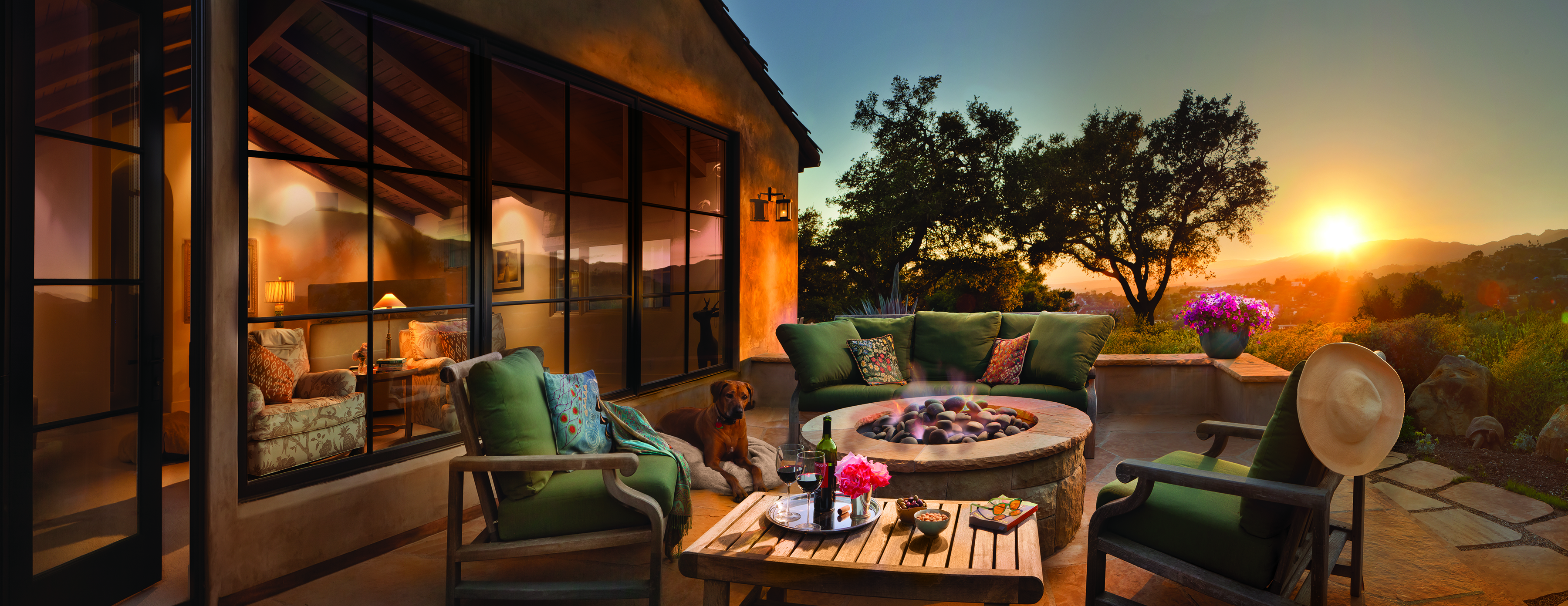Peace of Mind After the Jesusita Fire
Homebuilding Techniques Promote Wildfire Safety

Melissa and Christian Stepien made it out safely. Their home, unfortunately, was completely destroyed. The Jesusita Fire — a wind-driven blaze that scorched 80 homes and nearly 9,000 acres in the foothills above Santa Barbara in 2009 — burned so intensely through the Stepien house that even its foundation had to be abandoned. They were left with three acres of charred earth, a few big oak trees, and views that carry the eye from nearby Cathedral Peak, down into Rattlesnake Canyon, and on out to the ocean and mountains of Gaviota.
When it came time to regroup and get their heads around the complete rebuild of the place they called home, they found Bruce Giffin through a recommendation from a friend. “We heard a lot of good things about Bruce,” remembers Melissa. “And it turned out to be a good decision — he was excellent.”

Just six months earlier, the Tea Fire had destroyed more than 200 homes a few miles away, and those families offered a lot of support and advice for the victims of the Jesusita blaze. Giffin, as well, was sympathetic and patient with the Stepiens, remembers Christian. “He was very gracious and, at the same time, always on top of the project, holding weekly meetings with us and keeping his crew on point.”
Bound by strict building codes but afforded a bit of leeway in expanding their new home’s square footage, the Stepiens went with the house’s original architect, Hugh Twibell, who drew new plans on top of the existing footprint while making the living room and kitchen slightly bigger. Twibell also added more office space, and, most significantly, he raised the ceilings — with written approval from surrounding neighbors — about two feet to provide more spacious comfort.
For many of the countless details to come, Giffin drove the Stepiens to other Giffin & Crane projects, showing them an array of home features to see what they liked. For interior design, they brought in Genny Cummings with Indigo Interiors.

Outside, with a focus on flagstone pathways and world-class landscaping, horticulturist Carol Bornstein dreamed up a drought-tolerant design dominated by native plants. Soon enough, the birds — notably quail, hawks, owls, and vultures — came back in healthy numbers. So did sightings of bigger, photo-worthy wildlife, including deer, bobcat, and fox.
All said, their new home — described as a California Spanish ranch with hacienda traditions — covers roughly 4,000 square feet with three bedrooms, three and a half baths, and two offices. All of it conforms to state fire code, which calls for tempered glass, sprinklers, stucco, and eaves heavily treated to better withstand the intense heat of a wildfire, among many details designed to save lives and structures.
“Techniques used to improve a home’s resistance to fire also make it more energy efficient,” notes Giffin, who has written about the home-hardening techniques of going above and beyond building codes to better fortify a home against wildfire. To reduce the transfer of heat, he recommends insulating every wood cavity during construction, even those that don’t call for it, including covered patios, parapet walls, and stucco columns. He also recommends a one-inch-thick layer of foil-faced radiant insulation between a home’s plywood wall sheathing and its exterior layer of stucco. Windows, he suggests, ought to be dual-paned and aluminum-clad.

Another fire-safe feature found in the Stepien home is its conditioned crawl space, Giffin says. “Their home is in an extreme wildfire area, and we wanted to do everything we could to minimize risk.”
A conditioned crawl space, Giffin explains, is sealed off from the exterior — it’s essentially a mini basement — with a slab and insulated walls. Like a conditioned attic, a conditioned crawl space doesn’t have the typical mesh vents, which can provide entry points for embers during wind-driven firestorms. The techniques are fairly newly pioneered, Giffin adds, and need to be carefully executed to safeguard against potential issues with moisture and mold. “You have to understand the building science,” he says.
For added peace of mind, the Stepien backyard features a two-inch waterline with a valve that’ll hold a full-sized firehose.




You must be logged in to post a comment.